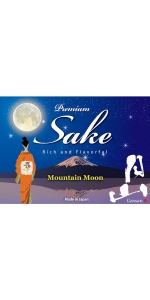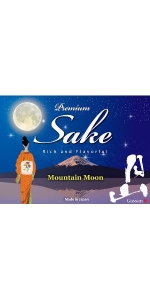Wine from Yoshida Brewing Company
The Award Winning Sake Brewery
Gassan, also known as Yoshida Sake Brewing Co., Ltd., is located in the small village of Yasugi. Yasugi is in the very Southernmost Japanese Prefecture of Shimane. The Kura or brewery was founded in 1743 and present owner Tomonori Yoshida-san's family took over the property in 1826; hence Yoshida-san is the 5th generation of family involvement and ownership with the Kura.
Over 200 years ago around Yasugi, the Amago-clan was reigning over the Sanin district. There, the clan established a castle where the feudal lord of Amago resided in the Age of Civil Wars. "GASSAN", took its premium sake brand name from the mountain in this area. Their time-honored tradition of sake brewing was established by special permission from the feudal lord of the House of Hirose. They have proudly maintained this tradition, handing down brewing secrets from generation to generation for over 180 years.
Their sake has received the gold award over ten times at the "Zenkoku Shinsyu Kanpyou Kai" (National New-Brewed Sake Contest), the foremost and authoritative contest in the Sake industry.
Gassan produces Tobin Sake or competition sakes from 18-liter tobins. The Tobin sake is very limited in production, but is marketed.
About their Fine Sake
Production is small at 700 Koku (or 14,000 9-liter cases in wine terms). Seven sake types are produced here by the ageless Master Toji, Tanaka-san, who is 84 years young. At artisanal breweries like Gassan water is all important and sure enough all of the water is sourced from mountain springs around Yasugi.
Typical of Western Style Sakes, their Nihon-Shu is big boned, rich and round, and balanced with lactic acid.
Why they got so many awards?
To make quality sake, it really depends on (1) Water, (2) Sake Rice, (3) Toji's Skill.
1. The Water Source:
Their sake is brewed with fine and super soft water, which the lord of the House of Hirose used in their tea ceremonies at the end of Edo period. (late 1800s)
The water Gassan uses for their sake is recognized as one of the best 100 waters in Japan. It was also known as one of the highest quality water in the "Fumai-style tea ceremony". Furthermore, as water varies according to climate conditions, we specially blend in other water sources to precisely control water hardness to maintain our exacting brewing requirements.
2. The Sake Rice:
Gassan does not hesitate to use high quality rice even though it may cost them. They focus on making outstanding sake for sake lovers. The sake mai or rice types used are:
- Yamada Nishiki
- Gohyakumangoku
- Sakanishiki
- Kairyoomachi
- Kannumai
3. The Master Toji's skills are superior to others:
The Master Toji Tanaka-san, is certified as "Modern master craftsman" by Ministry of Health, Labor and Welfare. The highly skilled people (a wide variety of things such as an entertainment, food, Metalwork, machine appliance assembling, repair, the sewing of clothes, carpenter) can be certified as "modern master craftsman " that Japanese government wants Masters to pass the technique to the younger generation.
Tanaka-san is also passing all of his skills to younger toji, Adachi-san. The uniqueness of Gassan is the mixture of Classic and Modern Toji skills that effect the flavor in the end.
This is the certificate of "Seishu Senmon Hyoukasha" (Sake Expert Assessor) that Tomonori Yoshida-san holds. There are about only 50 people who are certified. Out of all the 50, Yoshida-san is the Second person of the beginning. This certificate is presented by Alcoholic beverage research institute, the best liquor research organization in Japan. Whoever certified as Sake Expert Assessor, they can be called top taster, just like Master Sommelier in Wine world. Because the exams are so difficult, there are still only about 50 people certified.
Currently, there are about 1300 Kura exist in Japan, but most Kurabito (brewery people) do not hold such certificate. You need not only knowledge of sake, but also tasting skills to be certified. The producer, Yoshida-san is giving a 100% effort to create high quality sake.
Above all results, Gassan's sake is world-class sake
Gassan's sake is very easy and smooth to drink. Their constant pursuit of perfection has led to success at a national level. Now this high quality sake is available in the US.
Woodsy honeycomb, nutshell, and mushroom patch aromas with a satiny fruity-yet-dry medium-to-full body and a delicate savory mushroom stock, chestnut, and golden beet driven finish. A fine choice for tempura. 91 Points -Beverage Tasting Institute
RATING: 91 points (Exceptional)
CATEGORY: Junmai Ginjo Sake, Sake
ALCOHOL BY VOLUME: 15.4%
TASTING LOCATION: In Our Chicago Tasting Room
TASTING DATE: Dec-05-2012
WINE ID: 200767
Woodsy honeycomb, nutshell, and mushroom patch aromas with a satiny fruity-yet-dry medium-to-full body and a delicate savory mushroom stock, chestnut, and golden beet driven finish. A fine choice for tempura. 91 Points -Beverage Tasting Institute
RATING: 91 points (Exceptional)
CATEGORY: Junmai Ginjo Sake, Sake
ALCOHOL BY VOLUME: 15.4%
TASTING LOCATION: In Our Chicago Tasting Room
TASTING DATE: Dec-05-2012
WINE ID: 200767
- back
Selected Options
Wineries
Categories
Pricing
Countries
Regions
Grape Types
Wineries
Organic/Free Shipping
Domaine de la Janasse Chateauneuf-du-Pape Cuvee Vieilles Vignes is made from 65% Grenache, 20% Mourvèdre, 10% Syrah, 5% divers.
In contrast to Chaupin, which is made from old-vine Grenache on sandy soils, the cuvée Vieilles Vignes is from old vines of Grenache, Mourvedre, Syrah along with smaller percentages of other permitted varieties that are grown in these old vineyards. The wine is sourced from 4 terroirs: pebbly clay, sand, gravelly red clay and sandy limestone. Vieilles Vignes is always the most powerful and concentrated Châteauneuf-du-Pape cuvée made at Domaine de la Janasse.
Review:
The advantages of old vines are perhaps most evident in the more difficult vintages (whether hot and dry or cool and rainy). The 2021 Chateauneuf du Pape Vieilles Vignes is a strong effort, delivering supple, velvety waves of ripe black cherries and black raspberries. Medium to full-bodied, it's rich and concentrated without seeming at all heavy or unbalanced, finishing long and juicy. It's approximately 75% Grenache, 15% Mourvèdre, 5% Syrah and 5% other varieties, keeping in mind that up to 15% of the old Grenache vines are actually Clairette Rose.
-Wine Advocate 96 Points






